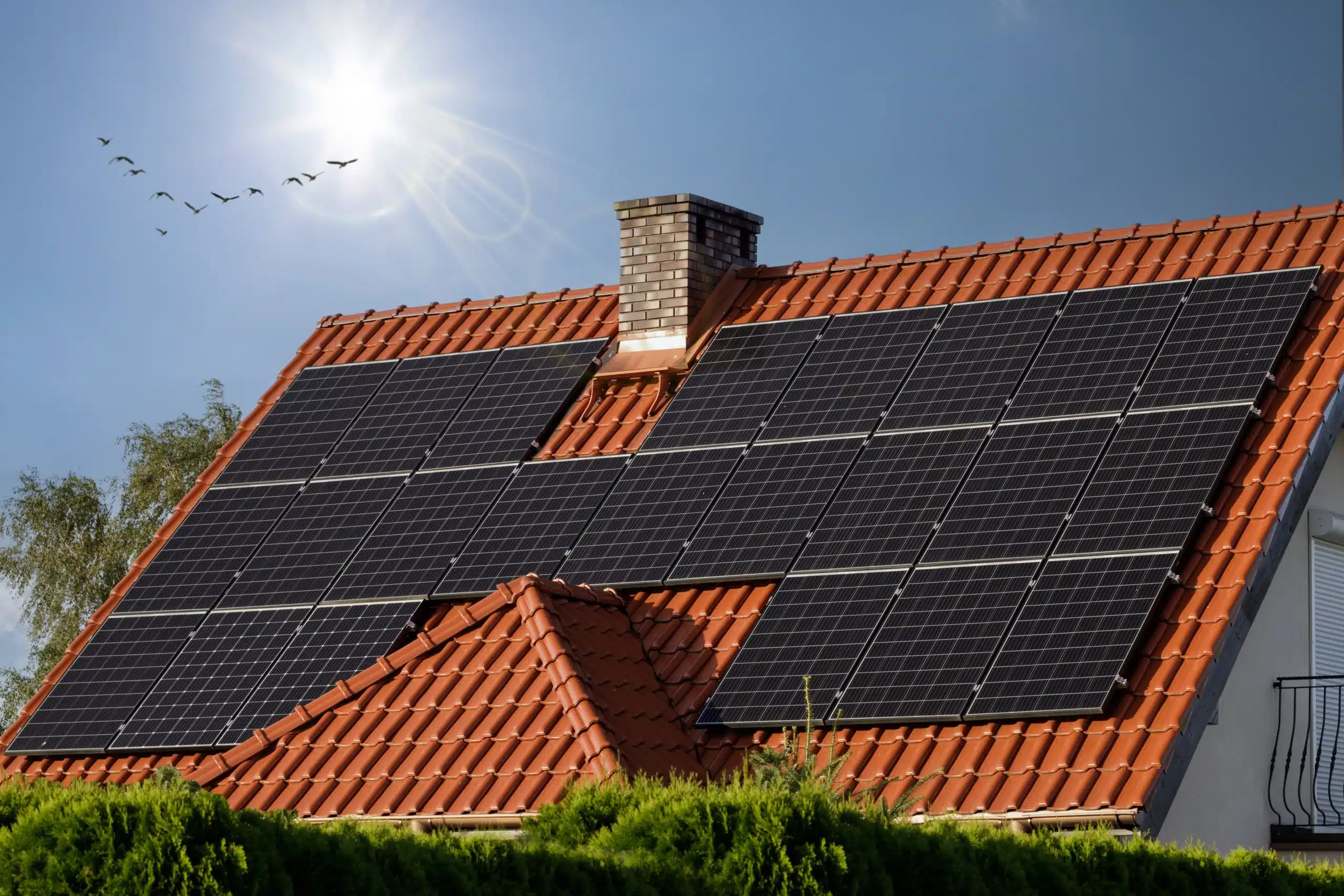![Can You Fit Solar Panels on a Flat Roof in the UK? [2025] 1 can you fit solar panels on a flat roof in the uk](https://www.solarpanelfunding.co.uk/wp-content/uploads/2025/10/Blog_Can-You-Fit-Solar-Panels-on-a-Flat-Roof-in-the-UK-scaled.webp)
- Can You Fit Solar Panels on a Flat Roof?
- How Efficient Are Flat Roof Solar Panels vs Sloped Roofs?
- How Are Flat Roof Solar Panels Installed?
- Do You Need Planning Permission for Flat Roof Solar Panels?
- What Are the Benefits of Solar Panels on a Flat Roof?
- Challenges of Installing Solar Panels on Flat Roofs
- Are There Solar Panel Alternatives for Flat Roofs?
- In Conclusion
Key Takeaways
💷 Flat roof solar systems often cost 10–20% more than standard sloped roof installs
🏠 Most UK residential flat roofs aren’t strong enough to hold solar panels without reinforcement.
🏢 Big commercial buildings are better suited to flat roof solar.
✅ You usually do not need planning permission to add solar panels to a flat roof.
![Can You Fit Solar Panels on a Flat Roof in the UK? [2025] 2 solar panels on a flat roof](https://www.solarpanelfunding.co.uk/wp-content/uploads/2025/10/Blog_Can-You-Fit-Solar-Panels-on-a-Flat-Roof-in-the-UK1-1024x631.webp)
Flat roofs can be great for solar panels because they give you a big, open space to catch as much sunlight as possible.
But installing solar panels on a flat roof is not always simple. Many roofs are not strong enough to hold the weight. Some systems need extra space. You also have to think about waterproofing and keeping the roof in good shape for the long run.
This guide looks at the upsides and the downsides, so you can decide if solar panels on a flat roof are right for you.
If you’re wondering whether your roof is suitable for solar panels, click below and fill in a few details. We’ll get back to you with answers and quotes.
Can You Fit Solar Panels on a Flat Roof?
Most home flat roofs in the UK are not designed for solar panels. They simply weren’t built to take the extra weight or withstand the wind load. For many homeowners, that makes flat roof solar a complicated and often expensive option.
By contrast, large commercial buildings (warehouses, offices, schools) usually have stronger flat roofs. They’re engineered to handle heavier loads and offer wide, open spaces without the shading problems you find on homes.
This is why most successful flat roof solar projects in the UK are on commercial roofs, not residential ones.
![Can You Fit Solar Panels on a Flat Roof in the UK? [2025] 3 how efficient are flat roof solar panels](https://www.solarpanelfunding.co.uk/wp-content/uploads/2025/10/Blog_Can-You-Fit-Solar-Panels-on-a-Flat-Roof-in-the-UK2-1024x631.webp)
How Efficient Are Flat Roof Solar Panels vs Sloped Roofs?
Solar panels on flat roofs can generate electricity just like on sloped roofs. But to do so well, they need to sit at the right angle and be secured properly.
In the UK, about 30 – 40° tilt is the sweet spot, but on flat roofs that’s rarely achievable. And at that angle, panels become much more exposed to strong winds. Plus, building rules say they cannot stick up more than 60cm above the roof.
So, most installations use 10–15° tilt, which reduces output slightly but is safer in wind.
However, low tilt angles make mounting harder. Panels must be weighed down properly to stop them shifting in high winds. Installers use a ballast mount, usually a plastic frame filled with heavy blocks, with the panel fixed tightly on top.
Sometimes installers drill the ballast into the roof for extra strength. But drilling adds weight and increases the risk of leaks. For most home flat roofs, this can quickly lead to serious problems.
Because the panels sit flatter, they’re also more prone to shading from nearby rooftops, chimneys, or HVAC units. To avoid this, rows need wider spacing, which reduces the total number of panels you can fit.
Flat roofs also tend to collect more dust and debris (since rainwater doesn’t wash them off as easily), so you’ll need more frequent cleaning and maintenance.
Pro tip: Always ask your installer what percentage of the output you’ll lose compared to a pitched rooftop setup. If it’s more than 10–15 %, that drop in return must be justified by lower costs or better coverage.
![Can You Fit Solar Panels on a Flat Roof in the UK? [2025] 4 Blog Can You Fit Solar Panels on a Flat Roof in the UK3](https://www.solarpanelfunding.co.uk/wp-content/uploads/2025/10/Blog_Can-You-Fit-Solar-Panels-on-a-Flat-Roof-in-the-UK3-1024x353.webp)
How Are Flat Roof Solar Panels Installed?
Flat roof solar panels need to be locked down securely because high winds are a real risk. Here’s how the job gets done:
An engineer checks your roof first. They carry out a structural survey to see if it can handle the extra weight.
If the roof is strong enough, the installer picks a ballast system to weigh the panels down without wrecking the roof surface.
In some cases, they drill the ballast into the roof to make the system even sturdier.
Panels are set up at a 10 to 15-degree angle and spaced out so they do not block sunlight from each other.
Once in place, the panels are wired into an inverter. This box turns the electricity from the panels (DC) into the type your home uses (AC).
Finally, the inverter is connected to your home’s power supply and to the National Grid.
Do You Need Planning Permission for Flat Roof Solar Panels?
As of December 2023, most flat roof solar systems fall under permitted development. Meaning you don’t usually need full planning permission.
✅ Rules to note
Panels must not protrude more than 60 cm above the roof.
Panels can’t extend above the highest part of the roof (chimneys excluded).
Listed buildings and conservation areas may still need approval.
In practice, this rule change mainly benefits commercial flat roofs, as most residential ones still aren’t structurally strong enough for solar panels.
![Can You Fit Solar Panels on a Flat Roof in the UK? [2025] 5 Blog Can You Fit Solar Panels on a Flat Roof in the UK4](https://www.solarpanelfunding.co.uk/wp-content/uploads/2025/10/Blog_Can-You-Fit-Solar-Panels-on-a-Flat-Roof-in-the-UK4-1024x631.webp)
What Are the Benefits of Solar Panels on a Flat Roof?
With permission rules out of the way, the next question is whether it’s worth installing solar panels on a flat roof. Luckily, it’s not all bad news. Here’s what flat roof solar can offer when it’s done right.
More flexibility: Unlike a sloped roof where panels follow the angle, on a flat roof you can face them south for maximum sunlight.
Less visible: Panels on flat roofs are often hidden from street view, which helps in conservation areas or style-restricted neighbourhoods.
Safer access: Installers and maintenance crews can move around more easily, without specialist equipment for steep slopes.
Better use of dead space: Commercial buildings and extensions often have wide, unused flat roofs that are perfect for panel placement.
Challenges of Installing Solar Panels on Flat Roofs
Despite the benefits, there are major challenges that make flat roof installs risky for most UK homes
Flat roofs struggle with heavy loads
A ballasted panel can weigh around 100 kg compared to just 20 kg for a pitched roof panel. A 10-panel system could add a tonne of extra weight
You will need a qualified expert to check if your flat roof can handle that much weight. In most cases, residential flat roofs are not strong enough.
Drilling can cause leaks
Sometimes ballast alone is not enough. Installers might need to drill into the roof to add extra stability.
But holes in a flat roof are a problem. Rainwater does not run off easily like it does on a sloped roof. Even a small leak can lead to major damage inside your home.
Lower tilt means lower efficiency
Because panels are angled lower, you’ll generate less electricity per panel than on a sloped roof. That makes your payback period longer unless funding offsets the shortfall.
Less roof space for solar panels
Flat roof systems need 0.5–1 m of edge clearance plus larger gaps between rows to avoid shading. That means you can fit fewer panels overall, cutting the system’s potential output.
Higher costs
Flat roof systems often cost more because of:
- Structural surveys
- Heavier mounting equipment
- Potential roof reinforcement
- Extra labour and maintenance
That’s why finance or funding can be the difference between “worth it” and “too risky.”
Are There Solar Panel Alternatives for Flat Roofs?
Flat roof solar isn’t always the best fit for every home, but that doesn’t mean you have to give up on solar altogether. There are other ways to generate clean energy that might work better for your roof and your budget.
![Can You Fit Solar Panels on a Flat Roof in the UK? [2025] 6 Blog Can You Fit Solar Panels on a Flat Roof in the UK5](https://www.solarpanelfunding.co.uk/wp-content/uploads/2025/10/Blog_Can-You-Fit-Solar-Panels-on-a-Flat-Roof-in-the-UK5-1024x631.webp)
Solar roof tiles (or solar shingles)
Solar roof tiles are exactly what they sound like. They’re roof materials that double up as solar panels. Each tile contains photovoltaic cells that generate electricity while acting as part of your roof covering.
They’re discreet and sleek, almost invisible from the street, which makes them ideal for listed buildings or homes in conservation areas.
Tiles are lighter than traditional panels and don’t need heavy mounts or ballast. That makes them a smart option if your flat roof can’t handle extra weight.
Portable or modular solar systems
Portable or modular solar systems give you more flexibility. They’re perfect if you rent, plan to move, or simply want something less permanent.
These kits can sit in a garden, on a shed roof, or on a balcony and you can add more modules later as your energy needs grow. They’re not as powerful as a fixed rooftop system, but they’re cost-effective and easy to relocate.
Ground-mounted solar systems
If your roof isn’t strong enough (or you just want to avoid the hassle altogether) a ground-mounted solar system could be your best option.
These setups are installed directly on the ground using metal framing. You can choose a fixed-tilt system (set at the ideal 30–40° angle) or a tracking system that follows the sun throughout the day for maximum generation.
Ground-mounted systems work best if you have enough outdoor space (like a garden, paddock, or unused land area) and if your property gets good sun exposure.
They’re often more efficient than rooftop systems, since you can control the tilt and spacing perfectly, and cleaning or maintenance is much easier.
They do cost a little more upfront because of the mounting structure and groundwork. You might also need planning permission if the system is large or over a certain height (usually more than 4 metres).
Which option is best for you?
The right solution depends on your budget, your roof’s structure, and how much power you need.
A qualified installer can help you weigh up whether a lightweight tile system, a small modular setup, or a traditional solar array makes the most sense.
In Conclusion
For UK homeowners, flat roof solar is often more trouble than it’s worth. The risks (leaks, weight issues, reduced efficiency, and higher upfront costs) outweigh the potential savings for most households.
But for big commercial buildings, flat roofs are a smart way to turn empty space into energy, with easier access and more design freedom.
If you’re a homeowner, you may be better off exploring:
- A pitched roof system
- A ground-mounted array (if you have space)
- Or a hybrid system combining panels with battery storage
Flat roof solar can work, but only if your roof is strong, your system is well-engineered, and you have funding or finance to make the numbers stack up.
Do solar panels work on flat roofs in the UK?
Yes, but not all roofs are suitable. Most home flat roofs need strengthening to handle the extra weight of the mounting system. Large commercial buildings are much better suited because they’re structurally stronger and have fewer shading problems.
Are flat roof solar panels less efficient than sloped roof panels?
Slightly. A sloped roof allows panels to sit at the ideal 30–40° angle, while flat roofs typically use 10–15°. That lower tilt reduces energy generation by around 10–15%, though you can offset that with more panels or optimal placement.
How much does a flat roof solar system cost in the UK?
Flat roof solar systems usually cost 10–20% more than standard rooftop installs. That’s because they need heavier mounting equipment, roof surveys, and sometimes structural reinforcement. A typical 3–4 kW system might start around £5,000–£8,000, depending on complexity.
Do solar panels damage flat roofs?
They can if installed incorrectly. Drilling, overloading, or poor waterproofing can lead to leaks or long-term roof damage. Always use an MCS-accredited installer and make sure your mounting system protects the membrane beneath the panels.
What are the best solar alternatives for flat roofs?
If your roof isn’t suitable, consider solar roof tiles, portable or modular solar systems, or ground-mounted arrays. These options are lighter, more flexible, and can often bypass the structural challenges of a flat roof.




